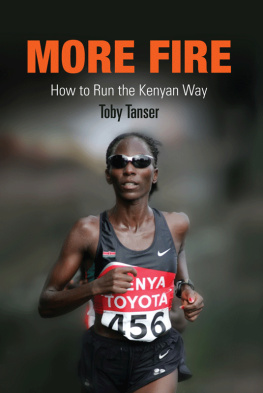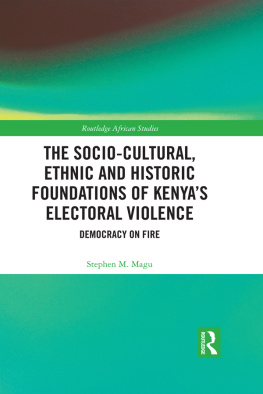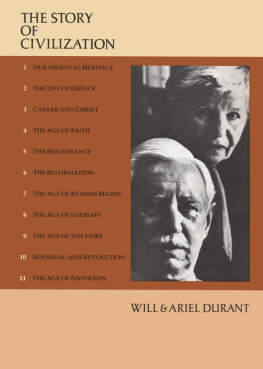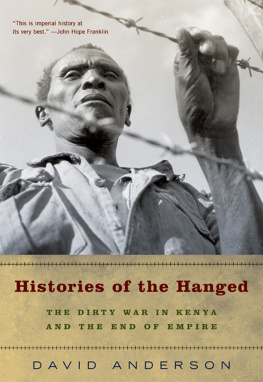Routledge Library Editions
Anthropology and Ethnography
AFRICA
In 26 Volumes
| I | Spirit Mediumship and Society in Africa | Beattie & Middleton |
| II | Custom & Politics in Urban Africa | Cohen |
| III | Urban Ethnicity | Cohen |
| IV | Order and Rebellion in Tribal Africa | Gluckman |
| V | Death, Property and the Ancestors | Goody |
| VI | The Family Estate in Africa | Gray & Gulliver |
| VII | Tradition and Transition in East Africa | Gulliver |
| VIII | The Human Factor in Changing Africa | Herskovits |
| IX | African Ecology and Human Evolution | Howell & Bourlire |
| X | The Nandi of Kenya | Huntingford |
| XI | Fields of Change among the Iteso of Kenya | Karp |
| XII | The Niger Journal of Richard and John Lander | Hallett |
| XIII | Defeating Mau Mau | Leakey |
| XIV | Mau Mau and the Kikuyu | Leakey |
| XV | Urbanization as a Social Process | Little |
| XVI | Family and Social Change in an African City | Marris |
| XVII | Widows and their Families | Marris |
| XVIII | Tribes without Rulers | Middleton & Tait |
| XIX | Neighbours and Nationals in an African City Ward | Parkin |
| XX | The Last Trek | Patterson |
| XXI | Women of Tropical Africa | Paulme |
| XXII | Hunger and Work in a Savage Tribe | Richards |
| XXIII | Leopards and Leaders | Ruel |
| XXIV | Western Civilization and the Natives of South African | Schapera |
| XXV | East African Societies | Shorter |
| XXVI | The Samburu | Spencer |

First published in 1952
Reprinted in 2004 by Routledge
2 Park Square, Milton Park, Abingdon, Oxon, 0X14 4RN
Transferred to Digital Printing 2006
Routledge is an imprint of the Taylor & Francis Group
All rights reserved. No part of this book may be reprinted or
reproduced or utilized in any form or by any electronic, mechanical,
or other means, now known or hereafter invented, including
photocopying and recording, or in any information storage or retrieval
system, without permission in writing from the publishers.
The publishers have made every effort to contact authors/copyright
holders of the works reprinted in Routledge Library Editions
Anthropology and Ethnography. This has not been possible in every case,
however, and we would welcome correspondence from those
individuals/companies we have been unable to trace.
These reprints are taken from original copies of each book. In many
cases the condition of these originals is not perfect. The publisher has
gone to great lengths to ensure the quality of these reprints, but wishes
to point out that certain characteristics of the original copies will, of
necessity, be apparent in reprints thereof.
British Library Cataloguing in Publication Data
A CIP catalogue record for this book is available from the British Library
Mau Mau and the Kikuyu ISBN
978-0-415-32993-4
ISBN 9781136531088 (ebk)
Miniset: Africa
Series: Routledge Library Editions Anthropology and Ethnography
Printed and bound by CPI Antony Rowe, Eastbourne

To the memory of
my great friend Chief Waruhiu
I dedicate this book
First published December nth 1952
Reprinted December 1952
1.2
CATALOGUE NO 5448/u
PREFACE
Some years ago I finished a very detailed study of the customs of the Kikuyu tribe, a book which, when published, will run to some 1,400 pages of print. It was my earnest hope that the publication of that book would help to make the Europeans of Kenya understand a little more about the Kikuyu people and so avoid the many mistakes which, so often, cause misunderstanding and enmity between the two groups.
But publication was delayed, and is delayed, and now the misunderstandings on the part of the European and the distrust on the part of the Kikuyu have reached a point where evil people have been able to bring into existence the present Mau Mau troubles, which I feel sure could have been avoided and need never have happened.
I have written this smaller book in the hope that a brief summary of some of the more important Kikuyu customs, and a discussion of their break-down under the impact of European civilization in the short space of fifty years, may help to make the British understand two things: why and how the Mau Mau has come into being, and also how, when it has been suppressed, things can be improved so that such a state of affairs need never again disturb the peace of the land I love so muchKenya. As I am better known for my work on the Prehistory of East Africa than as a student of social problems, I had better briefly state why I have felt qualified to write this book.
I was born and bred among the Kikuyu people, where my parents, who were C.M.D. missionaries, lived and worked for so long. I speak the Kikuyu language as well as, if not better than, English. I spent most of my youth with the Kikuyu, I am a member of the Kikuyu age-group called Mukanda, from which, I regret to say, not a few Mau Mau leaders have sprung. Others of my age-group are strongly anti-Mau Mau. I am also an initiated first-grade elder (Muthuri wa mburi imwe) of the tribe and I gave up two and a half years from my work on Prehistory in order to prepare my detailed book on the Kikuyu, working throughout this time with Kikuyu elders and with men of my age-group so as to be sure that all that I wrote down was absolutely correct.
I feel that, perhaps, I know the Kikuyu better than any white man livingI am in so many ways a Kikuyu myself and that is why I have dared to write this book, hoping and praying that it may help to bring understanding of the problems of the tribe and, in due course, peace to all the people of Kenya.
INTRODUCTION
In September 1952 it became necessary for the Kenya Government to declare a State of Emergency, as a result of the activities of an organization known as Mau Mau. Troops had to be flown out to the Colony, the Police Force had to be strengthened, the Police Reserve had to be mobilized and the Kenya Regiment called into action. Nobody knows how long this State of Emergency will last, or what the future holds in store, before peace and confidence can be restored and the normal life of the Colony be resumed.












